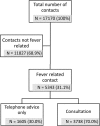Workload and management of childhood fever at general practice out-of-hours care: an observational cohort study
- PMID: 25991452
- PMCID: PMC4442146
- DOI: 10.1136/bmjopen-2014-007365
Workload and management of childhood fever at general practice out-of-hours care: an observational cohort study
Abstract
Objective: Even though childhood fever is mostly self-limiting, children with fever constitute a considerable workload in primary care. Little is known about the number of contacts and management during general practitioners' (GPs) out-of-hours care. We investigated all fever related telephone contacts, consultations, antibiotic prescriptions and paediatric referrals of children during GP out-of-hours care within 1 year.
Design: Observational cohort study.
Setting and patients: We performed an observational cohort study at a large Dutch GP out-of-hours service. Children (<12 years) whose parents contacted the GP out-of-hours service for a fever related illness in 2012 were included.
Main outcome measures: Number of contacts and consultations, antibiotic prescription rates and paediatric referral rates.
Results: We observed an average of 14.6 fever related contacts for children per day at GP out-of-hours services, with peaks during winter months. Of 17,170 contacts in 2012, 5343 (31.1%) were fever related and 70.0% resulted in a GP consultation. One in four consultations resulted in an antibiotic prescription. Prescriptions increased by age and referrals to secondary care decreased by age (p<0.001). The majority of parents (89.5%) contacted the out-of-hours service only once during a fever episode (89.5%) and 7.6% of children were referred to secondary care.
Conclusions: This study shows that childhood fever does account for a large workload at GP out-of-hours services. One in three contacts is fever related and 70% of those febrile children are called in to be assessed by a GP. One in four consultations for childhood fever results in antibiotic prescribing and most consultations are managed in primary care without referral.
Keywords: PRIMARY CARE; PUBLIC HEALTH.
Published by the BMJ Publishing Group Limited. For permission to use (where not already granted under a licence) please go to http://group.bmj.com/group/rights-licensing/permissions.
Figures
References
Publication types
MeSH terms
Substances
LinkOut - more resources
Full Text Sources
Other Literature Sources
Medical


